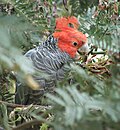Difference between revisions of "AY Honors/Parrots and Cockatoos/Answer Key"
| (11 intermediate revisions by the same user not shown) | |||
| Line 8: | Line 8: | ||
| classis = [[Bird|Aves]] | | classis = [[Bird|Aves]] | ||
| ordo = [[Psittaciformes]] | | ordo = [[Psittaciformes]] | ||
| − | | familia = [[Cacatuidae]] | + | | familia = [[Cockatoo|Cacatuidae]] |
| − | | genus = ''''' Callocephalon''''' | + | | subfamilia = [[Cockatoo|Cacatuinae]] |
| + | | genus = '''''Callocephalon''''' | ||
| genus_authority = [[Rene Primevere Lesson|Lesson]], 1837 | | genus_authority = [[Rene Primevere Lesson|Lesson]], 1837 | ||
| species = '''''C. fimbriatum ''''' | | species = '''''C. fimbriatum ''''' | ||
| − | | binomial = Callocephalon fimbriatum | + | | binomial = ''Callocephalon fimbriatum'' |
| binomial_authority = [[John B. Grant|Grant]], 1803 | | binomial_authority = [[John B. Grant|Grant]], 1803 | ||
| range_map = Bird range gang-gang cockatoo.png | | range_map = Bird range gang-gang cockatoo.png | ||
| Line 21: | Line 22: | ||
The '''Gang-gang Cockatoo''', ''Callocephalon fimbriatum '' is found in the cooler and wetter forests and woodlands of [[Australia]], particularly [[alpine]] [[bushland]]. Mostly mid grey in colour, the male has a red head and [[crest (bird)|crest]], while the female has a small fluffy grey crest. It ranges throughout south-eastern Australia and [[Tasmania]]. The Gang-gang Cockatoo is the faunal emblem of the [[Australian Capital Territory]]. It is easily identified by its distinctive call, which is described as resembling a creaky gate, or the sound of a cork being pulled from a wine bottle. | The '''Gang-gang Cockatoo''', ''Callocephalon fimbriatum '' is found in the cooler and wetter forests and woodlands of [[Australia]], particularly [[alpine]] [[bushland]]. Mostly mid grey in colour, the male has a red head and [[crest (bird)|crest]], while the female has a small fluffy grey crest. It ranges throughout south-eastern Australia and [[Tasmania]]. The Gang-gang Cockatoo is the faunal emblem of the [[Australian Capital Territory]]. It is easily identified by its distinctive call, which is described as resembling a creaky gate, or the sound of a cork being pulled from a wine bottle. | ||
| − | Gang- | + | Like all [[cockatoo]]s, Gang-gangs nest in closed trees. Loss of older, hollow-bearing trees and loss of feeding habitat across south-eastern Australia through land clearing has led to a significant reduction in the numbers of this cockatoo in recent years. |
==External links== | ==External links== | ||
Revision as of 00:54, 22 May 2006
The Gang-gang Cockatoo, Callocephalon fimbriatum is found in the cooler and wetter forests and woodlands of Australia, particularly alpine bushland. Mostly mid grey in colour, the male has a red head and crest, while the female has a small fluffy grey crest. It ranges throughout south-eastern Australia and Tasmania. The Gang-gang Cockatoo is the faunal emblem of the Australian Capital Territory. It is easily identified by its distinctive call, which is described as resembling a creaky gate, or the sound of a cork being pulled from a wine bottle.
Like all cockatoos, Gang-gangs nest in closed trees. Loss of older, hollow-bearing trees and loss of feeding habitat across south-eastern Australia through land clearing has led to a significant reduction in the numbers of this cockatoo in recent years.
External links
- ParrotScience - cockatoo heavy information site
- NSW National Parks & Wildlife - Proposed vulnerable species listing
- BirdLife Species Factsheet
References
- Flegg, Jim. Birds of Australia: Photographic Field Guide Sydney: Reed New Holland, 2002. (ISBN 1876334789)



